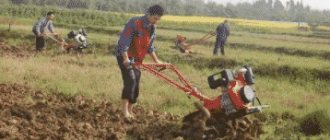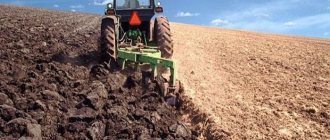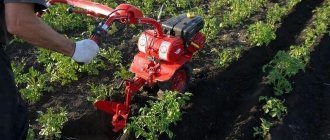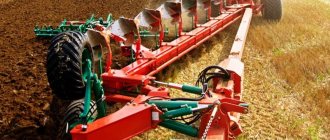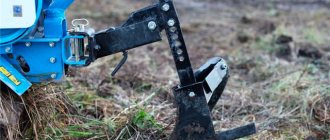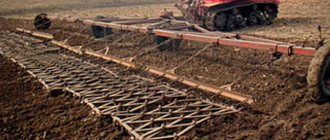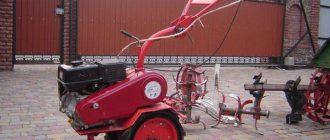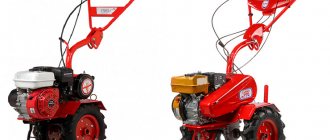Plowing land with a tractor and mini tractor price and cost - from 2000 rubles / hundred square meters
Timely and high-quality treated soil is a guarantee that the sowing campaign will be successful and the harvest will be high. To do this, the land is plowed with a tractor , making the soil favorable for sowing and growing various crops.
ready to qualitatively cultivate land in areas of any size. We have modern and reliable equipment that allows you to plow your garden with a tractor as quickly as possible. We also employ experienced and responsible drivers who can cope with tasks of any complexity. Therefore, even if you have to plow virgin soil, the soil after processing will be soft and suitable for further use.
When plowing land with a tractor is ordered, the price of the service is calculated in advance for each client and usually does not change in the end. Therefore, you can be sure that you will not have to adjust your budget much.
Plowing land with a tractor
The use of modern mechanized means allows soil cultivation to be carried out much faster and easier. The forks and shovels were replaced by productive modern equipment.
Plowing the land with a tractor is much faster, and in the midst of spring work, as a rule, every day counts, since the soil dries out quickly after the snow melts. During this period, it is very important not to miss the processing time. Early tillage of the soil with a tractor can lead to rather unfavorable consequences - the soil will be hard and rocky after drying. Delaying the processing time will lead to evaporation and blowing out of moisture, which will negatively affect the germination of crops, since there will be a lack of moisture.
Tillage using tractor equipment.
Using a tractor and special equipment when plowing the land minimizes costs and allows this labor-intensive part of the process to be completed much easier and faster.
Manual digging of the soil with a shovel and pitchfork was replaced by mechanized soil cultivation using productive equipment.
In this regard, the readiness of the soil for sowing when plowing the land with a tractor is directly dependent on the serviceability of the equipment and the speed of plowing.
The deadlines for spring work are compressed, it is important to use every day; after the snow melts, the ground quickly loses moisture. It is fundamentally important to meet deadlines when cultivating land. Plowing the soil ahead of schedule will harm the future harvest. When moisture is lost, the ground becomes hard and rocky, and the proper creation of a soil layer for sowing and plant growth is disrupted.
A delay in starting soil cultivation will cause a change in moisture regimes, causing sudden evaporation of moisture and drying out of the fertile layer. Lack of moisture will damage the simultaneous emergence of sown crops.
Why plow the land?
Plowing the land with a tractor is loosening the top layer of soil in order to improve its fertility. Autumn plowing before winter is carried out to saturate the soil with oxygen, ensure freezing of weeds, and also destroy the underground passages of rodents. Previously, peasants called it autumn plowing, since the land was cultivated when the first frosts occurred, that is, when it was cold, so to speak. On the surface, along with clods of earth, are the larvae of various pests, which die from the cold, and the underground passages of rodents are destroyed. In addition, loose soil absorbs moisture much better, and this will have a positive effect on fertility next season. And in order for the result to be even better, it is recommended to apply fertilizers during plowing.
In summer or spring, the soil is plowed with a tractor cutter to loosen the soil before planting. The depth of arable work, as a rule, depends on the crops that will be sown in a given area. Root crops require deeper plowing, but cereal plants do not need it.
Proper plowing of the soil with a tractor will not only help loosen the soil, but will also prevent erosion processes and salting.
Order virgin soil plowing in St. Petersburg and the Leningrad region
= There are really a lot of options, but I’ll stick to what I tried and liked.
Method 1: a barrel, if you move it = there will be a circle of clean earth with worms. There was no Sun - the process of photosynthesis did not work. At the beginning of my journey, I covered areas of land that were completely covered in weeds. First, I mowed it, added organic matter (all organic debris), watered it thoroughly, added Baikal M-1 or Siyanie (biological microorganisms) and covered everything with CARDBOARD, maybe cellophane or some cloth, but it costs money (in the future, I’ll say, everything will pay off) so that it does not fly away from the wind, lay the boards, earth...
Method 2: my method under the material: a plot of virgin soil (I have had an undug, overgrown garden for 10 years), nettles up to 2 meters high, roots the size of a finger - you can only take it with an ax. I began to master the word mowing in the fall - I trimmed everything at the root, then with a disk trimmer. YES, I worked hard, kept everything small, I had about 5-6 acres. I immediately sprayed it with Baikal-M! So that it gets on the cuttings of all plants, biologically useful organisms, once on the FOOD, begin to quickly multiply, eating DEAD GREENS. They do not feed live. We were lucky: the weather was cloudy for a couple of days. I scattered mustard as green manure for testing (it is the cheapest and most unpretentious). Two weeks later, the nettle began to grow from the root, and the mustard too, but, alas, the strength was not equal. I went through it a second time with a disk and line trimmer (I sprayed it with Baikal 2 times and scattered some mustard seeds). The autumn was warm and rainy, I scattered straw and even hay, in general, I covered what I could with black covering material. It was soon covered with snow. Spring came, I removed the material, BUT not everywhere, using the “barrel” method I left it until spring. But where I removed it, early in the spring I densely sowed green manure - mustard, oats, peas. There was a struggle there all summer, in the fall, having mowed everything, I sowed winter rye, and the next spring the rye fulfilled its purpose. So I became the owner of excellent LAND (without digging or weeding).
Method 3: start as in method 2, in the spring. As soon as the soil is ready, you CAN cultivate it with a light cultivator to a depth (50–100 mm) (loosening the surface layer), the weeds sprout, we do provocative loosening (at lunchtime in the bright sun the roots dry out), I still just went through the cultivator quickly 2 hundreds. A week later I repeated it. A week later, before planting potatoes, I repeated it 3 times. This is how I returned the overgrown land to CROPE ROTATION.
Method 4: Canadian technology - restore any soil in 2-3 years (thin branches rich in sugars were crushed, chips were obtained, which were scattered in a thin layer on the ground and mixed with cultivators to a depth of 50 mm). The sweetness effect is long-lasting and full-fledged, and you can always add more later. Maple as organic matter and until June everything sweet (leaves and branches) from grapes - the same sorghum - better than sugar, Supersweet Sylphium "M" + Typhon (winter hybrid) - sweet healthy green manure. Hogweed, daikon (very sweet), elderberry, grapevines...
Advantages of mechanized tillage
The advantages of cultivating soil with a tractor include:
- the ability to process large areas of land in a short time;
- high degree of soil saturation with oxygen;
- deep cultivation, allowing to turn over the soil layer;
- significant increase in productivity of work performed;
- reducing the labor intensity of plowing and human effort;
- the emergence of the possibility of combining several operations, for example, plowing the land and applying fertilizers to it.
What to do if you need to process a large area manually
When processing a large area of virgin soil by hand, a popular method is dividing the area into small segments, which are covered with a double layer of dense material at least 5 cm thick. You can use cardboard, straw, black film or spandbond, and press down with bricks.
Mulching virgin soil under the beds with cardboard
The ground overgrown with grass is left covered until autumn, when the greenery under such dense mulch has time to rot and rot. Thanks to humus, many earthworms will appear, which will loosen the soil, and the soil will be easier to work with. The disadvantage of this method is that the beds are ready for planting only at the beginning of the next season.
It is possible to prepare the land using inverted turf. Areas overgrown with grass are dug up manually with a shovel. Potatoes are planted in the resulting holes, which are covered with dug up turf, turning it over with the grass part down.
Digging virgin soil with turning over turf
The grass in the ground rots, thereby fertilizing the potatoes and promoting their growth. This method allows you to harvest the crop the first time you plant it. But the timing of planting potatoes must be observed.
If space for beds is needed for urgent planting, and it is not possible to wait until next year, you can use the option of bulk beds. The prepared fertile soil is poured directly onto virgin soil, and the rows are dug up and treated with targeted herbicides. Plants with a shallow root system (zucchini, cucumbers) can be planted in them.
- Read all comments from the beginning:
- 1
- 2
Dear Frans Khasanovich. The word “in general” referred only to the use of the plow in Poland and America. Don't overdo it, please. According to your comments. In 2012, I lived in the USA for almost three months. I've driven the car thousands of miles. I dare to assure you: on the highways there are restrictions - 40m/h (miles per hour) or 96km/h. This is basically it. More often - 30m/h. Sometimes both 50m/h and 60m/h are permissible. In cottage (in our language) villages - 15-20m/h (25-30km/h). And everywhere there is an excellent asphalt-concrete surface. Melancholy is not driving, just to avoid falling asleep at the wheel. As for lathes. I had to commission metal-cutting machines in Germany. In particular, in the city of Auerbach. By the evening, they set the machine to the “zero” level - and in the morning, it was as if they had done nothing. And in this way for several days. We found out that the whole city stands on rocky ground, actually on one rock, and our machine “staggers” along with the whole city and the plant: during the day the rock heated up - the city and the machine leaned there, during the night it cooled down - back. As I saw, natural phenomena take place and influence the accuracy of metalworking.
And returning to the topic. About agriculture. For me, rain is what it is, what it is not. Both drought and torrential rains all summer long. I always have a good harvest. For example, here. About potatoes. I am the author of these articles. moyhutor.net/kartofel.php moyhutor.net/kartofel-itogi-2012-goda.php I will only add that this area was virgin land until 2010. And it was designed specifically for the disc harrow and plow. As for the primary processing (I repeat, PRIMARY processing) of virgin soil for peas or buckwheat - this is exactly the place for the word “in general”! And in general, do not be a slave to outdated postulates! Sorry for being so blunt.
Maybe this debate is interesting from a “sporting” point of view. Apparently, we use a plow with skimmers for peas. I won’t argue, I’ll explain why a little later. And how will we raise the ground trampled (!) by cattle with deep ruts (according to the author) for buckwheat? Yes, 3-4 more times! And this is only in the first year. The seeds of a number of weeds remain viable for 10-30 years! And more! How much land does the author of the question have? 5 acres? 40 acres? A tractor with a plow and skimmers or whatever else will cost such a pretty penny! And then also your oh-oh-oh, what kind of hard work should you use? With this money and effort, it will be possible to buy everything ready for ten, or even twenty years. And don't worry! This is my explanation. And about herbicides in America. My “darling” ulcer, which reacts to any, almost any, product purchased in Russian stores, behaved quietly and calmly in America. At first I was wary, and then I ate any food. No poison! No chemistry! No delays in food storage! True, here we are not talking about the absence of the use of pesticides and herbicides, but about the use of pesticides of a very narrow, selective effect. For example, they do not affect the vegetables or fruits we grow. Or destroying only a certain type of “weed” (let’s call them that). And further. Yes! "East is a delicate matter". But agriculture is not a delicate matter at all. Working in the industrial enterprise is a credit to its employees - competent specialists worked there. What happened on collective and state farms? He started up a dozen tractors with combines and launched them into the field. And then for some reason the harvest failed! The money is state money. Not sorry! But Stanislav Timofeev, the author of the question, has to pay out of his own pocket!
Flaws
Despite the many obvious advantages of using technology, it is not advisable to use a tractor in all areas, since harrowing is necessary after mechanized plowing. In addition, the use of technology in areas infested with weeds leads to even greater clogging, because plowing is carried out using the moldboard method and weed seeds are spread throughout the area. That is why, before using a tractor on your site, it is necessary to take into account all the above factors.
Tractor plowing services
The cost of plowing the soil depends on the geometry and area of the plot, as well as the type of equipment used, be it a walk-behind tractor or a tractor. By the way, choosing equipment for performing arable work requires a certain amount of experience - using agricultural equipment that is too heavy will only, so to speak, clog the soil, while too light one may not cope with the task.
The tractor with plow is endowed with great power, so it can be used on large plots of land. Plowing the land with a tractor is especially profitable (the price per hundred square meters is on average 1,500 rubles) if the plot is virgin soil, that is, soil that has not been dug up for many years.
How to plow properly with a walk-behind tractor: plowing land, working with different attachments
And I suggest you immediately switch to a new and not yet familiar method for you, but a year or two will pass, a piece will NOT fall off, and you will have HUMAN VEGETABLE GARDEN.
This is the first step in the collection of YOUR personal KNOWLEDGE.
So, we plant vegetables on the ridge, and to begin with we just make lines on the ridge (as long as you are used to this), in the future you will want to try planting seeds STRANGLED.
For example, we plant beets, onions, and carrots either with a seeder or from a bag (the old way).
Then we lightly level it with a rake; of course, it’s good if you have hay, straw (mulch), that is, organic debris. You need to mulch lightly, a LITTLE BIT, and when the plants grow up and are visible, you can add freshly cut (at least withered) grass (this is your wealth) between the rows.
And it will be your hard work. And then you can be lazy - admire nature, communicate with children, with loved ones, and you will really have TIME for this. AND WITH THE WEEDS, YOU DECIDE FOR YOURSELF, I WILL NOT DRAG YOU BY YOUR EARS.
Types of land cultivation
Basic tillage includes various types of plowing (plough with a moldboard, moldless plow, flat cutters), cultivation, harrowing.
Plowing with a tractor provides loosening with the simultaneous placement of plant residues and fertilizers (manure, peat, humus). For this purpose, different plows are used, differing in the shape of the blade. Loosening, wrapping the topsoil, and crumbling largely depends on the shape of the plow.
When using a moldless plow, the soil is plowed to a depth of 30 cm without turning the layer. Experts recommend carrying out such deep plowing every 3 or 4 years, especially in the driest areas. This will help avoid moisture loss.
To enrich the soil with organic fertilizers, in intervals it is cultivated using disk ploughers, which rids the soil of weeds, loosens the top layer of soil, and increases productivity.
There are advantages to cultural plowing performed with a plow with skimmers. It makes it possible to carry out separate processing of the top and bottom layers of soil, as a result of which almost all weeds are destroyed, since all plant remains, seeds and roots are embedded deep in the plowed land.
What is the best way to process virgin soil?
During the virgin lands epic, not a single reserve was created. On the contrary, the existing ones were closed and their territory was plowed up. The scientific stations of the Academy of Sciences, where world ecological and steppe science was created, were also closed and plowed open. The dust storms of the mid-60s that swept over the steppes of the USSR were catastrophic.
In the 70-80s, under the guise of radical land improvement, several more million hectares of crushed stone, solonetzic and other soils unsuitable for normal agriculture were plowed under monocultures. This process continued until the early 90s.
The farming system that existed in the virgin lands was soil-intensive. In Northern Kazakhstan alone, the initial reserves of humus amounted to 4.3 billion tons. Of these, 1.2 billion tons, or 28.3%, were irretrievably lost in virgin arable land due to various types of erosion. The applied system of pure vapors on an area of up to 20% leads to the “burning” of humus. The so-called biological erosion decomposed 0.7 billion tons of humus and released at least 1 billion tons of carbon dioxide into the atmosphere. Thus, Soviet virgin soil made a significant contribution to the greenhouse effect of the planet.
Solid tracts of plowed soil, having a dark color, heat up greatly and provoke drought, which, when chronic, caused aridization of the entire steppe zone, causing a significant drying out of rivers and lakes, and, consequently, the entire global desertification.
Mass plowing also affected the state of the animal world of the steppe zone. Stocks of valuable hunting and commercial species of animals were undermined and in some places completely destroyed.
The development of new lands took place in a zone of risky agriculture with harsh climatic conditions, and at the same time, the process of desolation of Central Russia, the historical breadbasket, continued due to the outflow of large human and material resources to the east. Over several decades of agricultural development, the steppe nature of the Volga region, the Urals and Kazakhstan has degraded more than central Russia over the centuries of the existence of developed agriculture here.
The totality of environmental and socio-economic consequences of the development of virgin lands shows that the modern structure of land use needs fundamental changes. The essence of these changes is that grain farming with the production of high-quality varieties of wheat should be focused on the best soils using effective agricultural technology and adaptive landscape farming methods. Low-productive arable land in virgin regions, where the production of marketable grain is unprofitable, should be converted into hay and pasture land. This will make it possible to create in the steppe regions a zone of harmonious combination of conservation agriculture and highly efficient cattle breeding.
Processing virgin soil at the dacha may be needed at any time. This is usually done to expand the area for garden beds, as well as when redeveloping or purchasing a new plot. Our article will tell you about the basic rules for processing virgin soil and preparing it for planting vegetable crops.
Virgin land is an uncultivated plot of land that has not been plowed for more than 20 years. Such soil is rested and maximally full of nutrients necessary for plants. However, summer residents are more concerned about the possibility of using such a plot for a vegetable garden.
